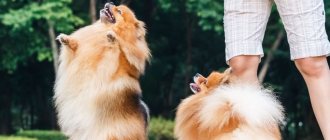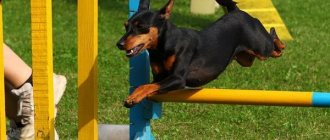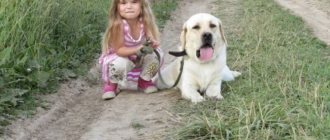How does obedience differ from OKD?
OKD, unlike Obidiens, is a national standard. Therefore, there are no world championships in OKD. In addition, these standards differ in the complexity of the exercises and the severity of the judging.
Obidience-1 is a simple standard, there are quite simplified exercises that any beginner can cope with, if, of course, they work.
This standard is within the reach of any dog. The judges never judge speed here, and never, say, an Asian Shepherd will be penalized for running slower than a Malinois.
But judges pay a lot of attention to the dog’s desire to cooperate and work. If the dog is sad and reluctant to do the exercises, even with good technique, such a couple will not receive high marks.
The standard says: the dog must be happy. And if the handler was unable to achieve this, if the dog does not enjoy the performance and is stressed, then “excellent” will not work.
We have different dogs: corgis, chihuahuas, Belgian shepherds, retrievers, border collies. The winner of the Russian Cup 2021 is a Staffordshire bull terrier.
Three classes of insults:
- Obidience-1
Primary class, the easiest standard. Dogs aged 10 months or older can take part in competitions. In Russia, animals over 8 months of age are allowed.
- Obidience-2
A more complex level of exercise, dogs aged 10 months and older are allowed.
- Obidience-3
International level. The most difficult exercises, the age of dogs is from 15 months.
To move to the next level, the dog must show “excellent” based on the totality of all grades in the previous class.
Subscribe to the newsletter and get a discount at the pet store “Lubimchik”
Thanks for subscribing!
Obidience: rules
The standard includes 10 exercises.
- Holding a group of four dogs in the “sit” position: the dogs sit for 2 minutes, the handlers go to cover.
- Holding in the group in the “lying down” position: the dogs are laid down one by one, the handlers stand at a distance of 10 meters opposite the dogs, after a minute, at the direction of the steward, they call the dogs one by one.
- Movement side by side: at each competition a new movement pattern is used, movement is tested at three paces - normal walk, slow walk and run, turns to the right, left, circle, side steps to the left and right, moving back about 15 meters with a right or left turn. Throughout the entire exercise, the dog must maintain the correct position. Obedience video exercises
- Retrieval by direction: the dog is sent from the starting point to the marking cone at a distance of 10 meters, stops there at the handler’s command, and then, on command, is sent to either the right or left dumbbell (determined by drawing lots). Obedience video exercises
- Sampling: Of the eight sampling items (wooden sticks), one has the scent of a conductor. Within 30 seconds, the dog must find the stick and bring it to the handler. Obedience video exercises
- Recall with stop and lay down. The handler puts the dog down and moves away to a distance of 30 meters. At the steward's direction, he calls the dog. After 10 meters, the handler must stop the dog with a command, then, at the direction of the steward, call him again, and after another 10 meters, put the dog down with a command. At the direction of the steward, call again. The speed in all areas of movement should be the same, and the dog’s adoption of the “standing” and “lying” positions should be fast. The dog must not move more than two lengths after the command. Obedience video exercises
- Remote control (complex). Change of sitting/lying/standing positions, 6 shifts in total per exercise. The handler is located at a distance of about 20 meters from the dog. Obedience video exercises
- Expulsion in a given direction. From the starting point, the dog is sent in a straight line to a distance of about 10 meters, where the handler stops the dog with a command. Then, at the steward’s command, the handler sends the dog to a square marked with marking cones, located 30 meters from the point where the dog stopped. After the dog runs into the square, the handler must put it down in the square with a command. At the direction of the steward, the handler begins to move towards the dog. Not reaching about two meters from the dog, at the direction of the steward, the handler makes either a left or right turn (depending on where the square stood), walks another 8 meters and turns to the starting point. Having walked approximately half the distance to the starting point, the handler, at the direction of the steward, calls the dog and continues to move. The dog must quickly come running and, while moving, settle into the main position and follow with the handler to the starting point. Obedience video exercises
- Positions from movement: while moving side by side at a normal pace, the dog alternately takes three positions - “sit”, “stand” and “lie”. After taking the position, the handler, without stopping, walks about another 5 meters, turns around and moves towards the dog. Having walked about 2 meters without stopping, he turns to the dog and, having caught up with it, gives the command “near”, continuing to move. The dog must quickly take a position and remain in it until the command “near”. Obedience video exercises
- Sending to the cone, fixing, fetching through the barrier: from the starting point, the dog is sent to the cone, which is located opposite the start at a distance of 20 meters. The dog should run around the cone and start moving back towards the handler. The handler must stop the dog with a command (sit/stand/down - determined by drawing lots) between two and 10 meters after the cone. Then, at the direction of the steward, the dog is sent to either the left or right fetch. The aports lie to the right and left of the conductor at a distance of 5 meters from each other. There are two barriers at a distance of 5 meters from the conductor. The dog’s task is to take the fetch and, jumping over the barrier with it, run to the handler. Obedience video exercises
You can sign up for a consultation with Tatyana Shamanova by email at digisky(dog)yandex.ru
History of origin
Obedience for dogs originated in England, and the basis for it was an obedience course invented back in 1924. By the way, “obedience” in translation means just “obedience.” In the USSR, at the time of the emergence of obedience, there was an analogue of an obedience course - a general training course (GTC).
Over time, this sport gained increasing popularity among trainers and their pets, and so, in 1950, the first national obedience competitions were held, and in 1990, the world championship.
In 1998, during the international dog show “Eurasia”, teams of trainers from Russia were presented among the participants for the first time.
Exercises included in the obedience program
If we understand the preparation for obedience and the term itself, let’s look further at exactly what exercises the dog performs at the championship.
- First of all, all dogs are divided into groups and seated at a distance of at least 3 meters between each participant. The owner of the animal gives his pet the command to Sit and then leaves for 1-2 minutes, returning after this time. The judges carefully evaluate how the dog behaves - its score will be reduced if the animal shows nervousness and excitement, does not sit still, or changes its body position. If there are external stimuli, the rules allow for the fact that the dog can look around and raise its head.
- The dogs are formed into groups and the appropriate commands are given for 4 minutes - “Lie down” and “Stand”, “Sit”. At the last command, the animal must sit next to its owner, and it is from this position that the command “Lie down” is given to it, after which the owner leaves.
It is while the dog is lying down for 3-4 minutes that it will be provoked and irritated so that it gets up and does not comply with the command - this is done by specially trained championship staff. A well-trained animal will not succumb to such tricks - when the owner returns, he stands behind the pet at a distance of 3 m, giving the command “Nearby”. If during the provocation the dog becomes nervous and barks, gets up and sits down again, or shows anxiety, the points will be reduced.
- At this stage, the judges check how the dog will carry out the command given by the owner - “Sit”! The dog walks without a leash, walks on the left side, without retreating following its owner, who can move quickly or slowly, stop and turn - all this must be done by the pet walking next to him. If the dog walks at a distance of half a meter from the owner, or runs away completely, the task is considered to have failed.
- Checking the dog for accurate execution of the commands “Stand”, “Sit”, “Lie down” and “Come to me”. At the very beginning, the pet is given the command “Stand” - at this stage the dog must stand up, and the owner continues to walk. When approaching the animal, the owner gives the command “Near” and they continue the subsequent movement together. Next, the owner gives commands such as “Sit”, and then “Lie down” - the judges watch how the animal carries out the commands, without reacting to external stimuli and provocations, with a minimum of extraneous movements. Particular attention is paid to the execution of the “Nearby” command.
- Next, the command “Come to me” is given - this command is given to the dog from the last position in a sitting and lying position. At the very beginning, the dog is given the command “Lie down” and the owner, according to the rules, moves 3 meters away from the pet - the animal is called and as soon as 1/3 of the path has been passed, it is stopped. In this position, they wait a minute and then give the command “Come to me”, and after passing 2/3 of the way they again give the command “Lie down” and again call the animal to the owner. At the first call, the owner is allowed to call the animal by name - the dog must move towards the owner at a trot, and a mistake is that the animal walks at a slow pace.
- Next, the judges check how the dog demonstrates its search skills - it can find and bring this or that object upon request. In this case, the dog is given commands such as “Forward”, “Stand”, “Look”, “Fetch”. When performing this set of commands, dumbbells are used - they are placed in one row, maintaining a distance of 5 meters between each object. From a distance, the owner gives commands and directs his pet from the left to the right dumbbell and vice versa, giving the commands “Take” and bring him this or that object. The judges at this point pay special attention to how the animal carries out commands, its speed and its intelligence in choosing the shortest path. If the animal chews or gnaws wooden dumbbells, the points are reduced accordingly.
- Next, the judges evaluate how the animal takes the barrier in order to comply with the command and take this or that metal object. In this case, the owner gives such commands as “Barrier” and “Bring”, “Give”. The dog and its owner stand in front of the barrier itself, with a distance of 3 meters - in this case the dumbbell is thrown over the bar and the command “Barrier” is given. The animal must jump over the barrier, take the thrown object and bring it to its owner, returning back, also jumping over the barrier, without relying on its bar.
- In the process of taking part in the competition, the dog is tested for its ability to carry out the commands “Seek” and “Fetch”, “Give”. In this case, the owner holds a block of wood, marked with a starting number, in his hands for some time, then places it among other similar objects, maintaining a distance of 10 m between each other. Among all the objects, the animal must choose and bring the object that the owner was holding in his hands, and bring it. The animal is given 30 seconds for this exercise. time - it is forbidden to let an animal smell an object in advance, and if he is caught doing this, then the task is considered to have not been completed.
- The competition ends by checking the dog to see if it follows commands from a distance. In this case, the animal is placed in a prone position, the owner moves away from her at a distance of 14-15 meters and gives commands from such a distance. The selection criterion is the speed of execution of the given command, the absence of a change in body position, or movement forward.
Dogs for obedience
Certain breeds are the most successful in training and can be trained quickly due to their breed characteristics and intelligence. For example, border collies, Dobermans, Labradors, golden retrievers, and German shepherds quickly master obedience. Representatives of hounds, sled breeds, and terriers, bred to perform specific tasks regardless of a person, cope worse with the assigned task. Although this does not mean that they cannot be taught obedience. It will just take more time and effort.











